Since I've recently been discussing the fate of classical music (see this post, and this one too) I've decided to jump this post from March of 2012 to the top of the queue. Why? Because one thing that happened to classical music is that its techniques and devices have been put to use in crafting music for the soundtracks of films, including cartoons. In the case of What's Opera, Doc extracts from Wagner operas were used.
* * * * *
What's Opera Doc from 2K HistoryClips on Vimeo.
It is a truth universally acknowledged that What’s Opera, Doc? is one of the finest cartoons ever made. It satirizes opera, Wagner in particular; it parodies Disney’s Fantasia, and, for that matter, it parodies the routines of its stars, Bugs Bunny and Elmer Fudd. The production was, by Warner Brother’s standards, lavish, and the layouts, by Maurice Noble, are inspired.
All of that’s obvious. What’s not so obvious is that the film plays on the nature of reality in a way that’s reminiscent of Dance of the Hours from Disney's Fantasia. As I’ve argued in Animal Passion? Hyacinth Hippo and Ben Ali Gator, that episode depicts the inability of animal dancers to stay in role with the result that, when Ben Ali Gator courts Hyacinth Hippo we don’t know whether they’re acting roles or whether their passion is, well, real. Something like that is going on in What’s Opera, Doc? Elmer Fudd is in role as, well, Siegfried I guess, from beginning to end, but Bugs is not.
Note: I’m not going to comment on the design. But you should pay attention to it. Note the colors, the camera angles, and the use of lines. It’s really exquisite.
Kill the Wabbit
Let’s start at the beginning. As the title card and credits roll we hear an orchestra warming up. We thus know that, yep, as the title says, this is going to be opera. The opening music is wild and stormy and we see a stormy sky, and then a large hulking shadow appears projected against a cliff. More sky and lightening, and then we see that the large shadow is projected by a rather small fellow:
It this point a simple, and rather old, point has been made: things aren’t always what they seem to be. The camera zooms in and it’s Elmer Fudd, in heroic costume as a Nordic warrior, informing us that he’s “hunting wabbits.”
As Elmer sings “Kill the wabbit” while poking his spear into a rabbit hole, Bugs hears him and is rather distressed. Bugs approaches and delivers his classic line, “What’s up, Doc?” Bugs, however, is not in costume and so not, presumably, in role. He’s just Bugs.
For whatever reason, Elmer is completely oblivious to the identity of this character, which has us, the audience, wondering what indeed is up? When Bugs asks the mighty Nordic warrior just how he expects to kill the rabbit, Elmer replies that he’ll use his spear and magic helmet. The spear, of course, is just a standard weapon, the Nordic warrior equivalent of Elmer’s more usual shotgun. But a magic helmet, that’s something else entirely and gives the Nordic warrior powers that Elmer never had. Note how the helmet glows when Elmer mentions it:
Perhaps sensing a challenge, Elmer offers to demonstrate the helmet’s powers and climbs to the top of a tall promontory and summons up foul weather in a scene reminiscent of the dream sequence from The Sorcerer’s Apprentice. Lightening strikes a tree next to Bugs, who’s OK. But he starts running.
True Love
Elmer sets out in hot pursuit until he comes to a halt at the foot of another promontory, atop of which he spies, and is smitten by, Brünnhilde. Brünnhilde, we see instantly, is Bugs in drag, and she’s plunked atop an enormously overweight horse, as though the horse had to make up for the lack of fat on the proverbial operatic Fat Lady as played by Bugs. We assume, of course, that Bugs knows full well he’s in costume, playing a role.
They dance a pas de deux, Elmer looking rather boyish, at the end of which Bugs retreats atop another tower, this one with steps up the side and a gazebo at the top. They sing a passionate duet as Elmer climbs the steps. He reaches her, she falls into his arms, and her helmet falls away, revealing rabbit’s ears. The jig is up!
Elmer is enraged. As Bugs flees, the Nordic warrior invokes his powers again and conjures up a powerful storm, leaving Bugs apparently dead from a lightening strike.
Upon spotting Bugs’ body, Elmer is suddenly filled with remorse. He rushes to the body, picks it up, and carries it off to, well, it’s not clear exactly where, Valhalla one presumes. As he does so the camera zooms in on Bugs, who reveals that he’s alive, asking: What did ya’ expect in an opera, a happy ending?
Comparative Wabbitology
According to the Wikipedia article on What’s Opera, Doc? this is one of only three cartoons in which Elmer gets the “upper hand” on Bugs. The others are Rabbit Rampage and Hare Brush. Neither of them is, shall we say, a “standard” Bugs and Elmer cartoon. And in neither of them does Elmer think that he’s killed Bugs.
Rabbit Rampage is an exercise in meta-level surrealism comparable to Duck Amuck. Bugs is the lone on-screen character addressing himself to an unseen artist who keeps redrawing both the setting and Bugs himself. The camera pulls back at the very end to reveal that Elmer’s the animator. Far from being Bugs’ killer, Elmer is, in a sense, the one who creates Bugs, who gives him, if not life, at least visible substance.
In Hare Brush, Bugs and Elmer switch roles. As the cartoon opens Elmer is a wealthy industrialist who thinks he’s a rabbit; he hops on all fours and munches a carrot. His board commits him to an asylum, where we see him in his room in a rabbit suit. This that and the other happens; Bugs takes a mind-altering pill; and voilà! bunny-suit Elmer gets chased around the countryside by Bugs-as-Elmer with a shotgun and wearing hunting clothes. A tax agent nabs Bugs-as-Elmer and hauls him off to prison, with bunny-suit Elmer basking in his triumph. But: he doesn’t think Bugs is dead and there’s no mourning.
So, in one case, Rabbit Rampage, Elmer has had the upper hand from the beginning, but we don’t know that because we aren’t aware of his role until the end. In the other case we have, if not quite role reversal from the beginning, certainly role confusion; Elmer thinks he’s a rabbit and Bugs hunts him. The point is that Elmer having the upper hand at the END isn’t just a matter of the final moves in the plot. Rather, it seems to entail a reconfiguration of the whole cartoon from beginning to end. We’re in the intellectual territory Lévi-Strauss entered in his studies of myth, where he showed how a large body of South American myths was based on the strategic rearrangement and transformation of a relatively few underlying elements (see my posts From Bollocks to Lévi-Strauss on Myth and The King’s Wayward Eye: For Claude Lévi-Strauss).
And that reconfiguration certainly includes playing with the conventions of reality. In Rabbit Rampage the so-called fourth wall is destroyed from the very beginning. At every step of the way we are told, in one way or another, that this is a cartoon. In Hare Brush Elmer is crazy and Bugs is drugged.
Things aren’t what they seem.
What’s Up, Really?
That’s certainly the case with What’s Opera, Doc? From the beginning to the end, Elmer is caught up in a role in an opera; he never appears as ordinary Elmer. When he enters, Bugs does not appear to be playing a role. But he’s worried about this Nordic warrior who’s after him. At first he’s just Bugs. But, when Nordic warrior sees him as “the wabbit” he dons a costume and takes a role in the opera. He becomes Nordic warrior’s beloved Brünnhilde.
The two then dance together and serenade one another. That is quite unlike anything that happened in either Hare Brush or Rabbit Rampage. And this, I suggest, is why, at the end, Elmer mourns the dead Bugs—who isn’t really dead. Yes, when he realizes the deception he goes into a rage and, in that rage, conjures up a storm that lays Bugs/Brünnhilde out for dead. When the storm dissipates and he sees Bug/Brünhilde there, well his rage is gone too and so he mourns the wabbit, the wabbit with whom he’d danced a dance of love and sang a song of love.
What else could he do?
We’re in the land of myth logic and the rules are different from those in the real world. In myth logic mourning is the necessary answer to passionate love, as destructive rage is the necessary answer to deception. And perhaps that’s it, it was the deception that angered Elmer/Nordic warrior and it was the deception for which he sought revenge. That is, he wasn’t merely hunting a wabbit, as he was at the beginning, he was exacting revenge.
And that’s different from simply hunting rabbits.
At this point I see a pile of questions which I’m not prepared to address. For one thing, Elmer vs. Bugs had been a staple of Warner Brothers cartoons for years. Most people in the audience would know this. But how would What’s Opera, Doc? play for those who didn’t know that? And what about relatively young children who had not yet absorbed the conventions of cartoons, such as the fact that, no matter how much violence we see, no one is injured?
Not only is the Bugs/Elmer conflict a known item, but it’s almost always presented as an on-going conflict. Elmer and Bugs have a long-standing relationship. Elmer’s not hunting any arbitrary rabbit, he’s hunting this particular wabbit. It’s personal, and has been for some time.
Family Matters
What does it mean to be locked into THAT kind of conflict? It’s as though a significant component of Elmer’s identity is invested in his conflict with Bugs. That kind of conflict is steeped in ambivalence. The love duet in this cartoon was no mere act; it revealed an aspect of the relationship between Bugs and Elmer that’s otherwise been completely masked in standard-issue cartoon violence and conflict.
While Bugs and Elmer aren’t even the same species, much less the same family, that is only appearance. Or, if you will, that’s art. The response these cartoons evoke in us, the audience, that response speaks to close personal relationships. It’s about family. Wife and husband, parent and child, sibling and sibling, that’s what we’re dealing with. Those relationships are fraught with ambivalence, ambivalence that’s on full display in What’s Opera, Doc?
Now all I need’s a good explicit argument to that effect, rather than a few paragraphs of tap dancing and hand waving. That argument, that’s going to take more than a blog post, much more.
BTW, did you look closely at those screen shots, the color and layout?
* * * * *
Bonus points: As you know, Michael Barrier insists on the importance of animate acting. That is extraordinarily important in this cartoon. Pick one scene and explicate the acting subtleties it displays.

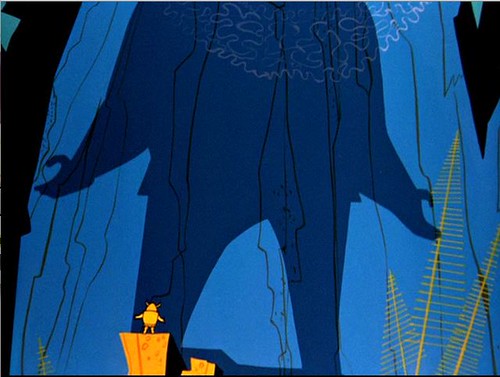
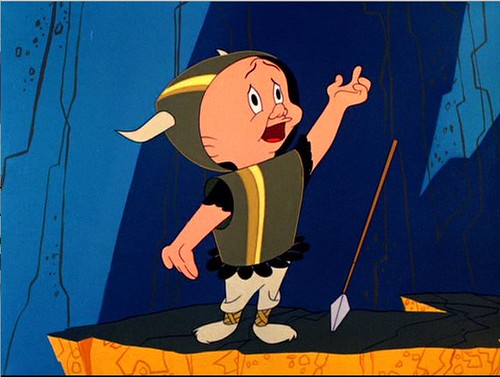



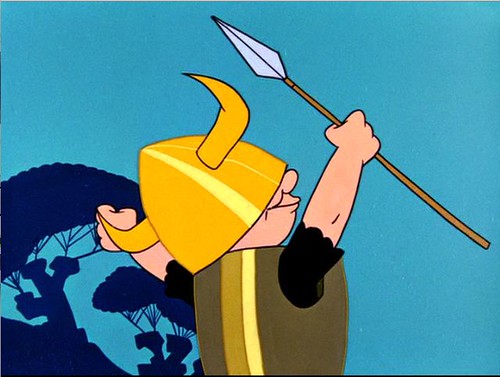

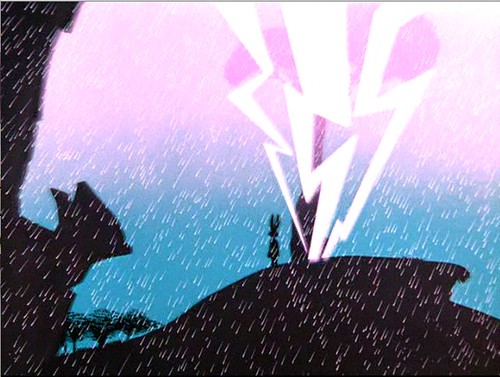
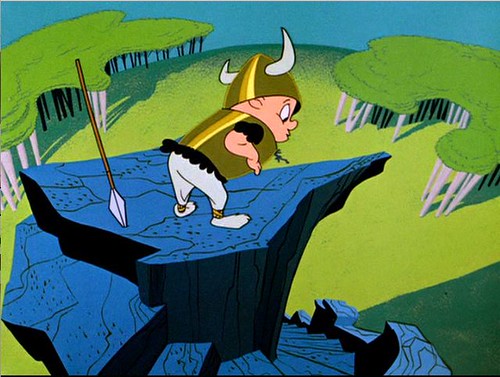

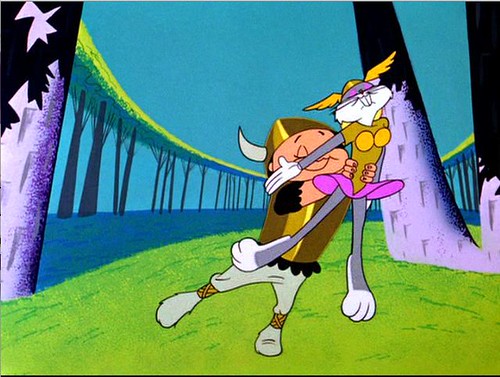

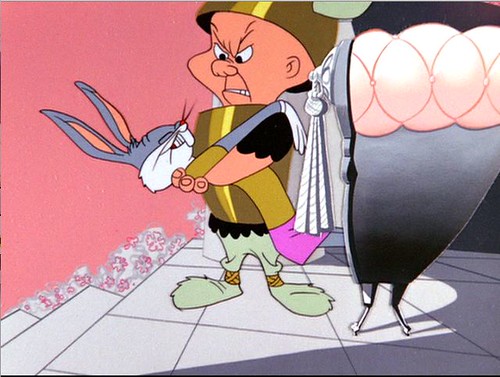

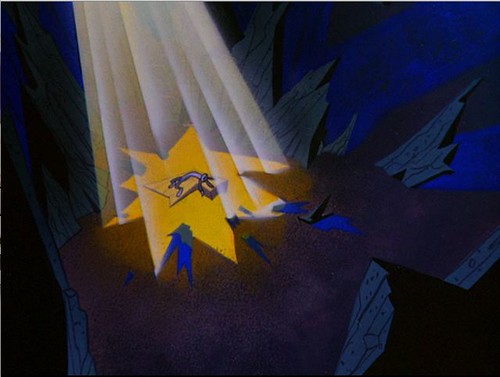



"In myth logic mourning is the necessary answer to passionate love, as destructive rage is the necessary answer to deception."
ReplyDeleteThese concepts seem clear at times in the texts I spend most of my time with but utterly melt into each other. I also appear to have a gender difference.
Male warrior, suffers massive mental trauma in battle, sees vision of god/ turns hairy/ takes to the woods/ lives on a vegetarian diet/ develops power of prophecy. In one case the reason is he killed his sisters sons. The battle is in all cases futile and highly destructive.
When its a holy-man its his act of rape that causes mental distress. But both are somewhat penitential and plaintive sinners. Sexual transgression by the warrior or his wife also overlaps or is hinted at as a potential reason for aggression, trauma/ transformation.
With females story seems different, mental trauma due to loss of a loved one, same physical transformation as warrior/ holy-man but she takes to the woods and eats rabbits raw and uncooked, utterly destructive. In later examples has a taste for human blood that appears highly sexual. Her cure in one text to turn her in to the best little wife is repeated acts of sexual intercourse, bathing and music.
A treatment used to treat external melancholia caused by love sickness and or grief.
Both genders seem to suffer the same types of illness but with dramatic differences in behaviour resulting from distinctions in diet/ modes of obtaining different foodstuffs.
Will chew through the texts see if I have missed something with regard to female transformation. Destructive rage as the answer to deception may explain the death at the end of one tale. Ends with a moral twist as the deception was a mis-observation.
Seems to be a high degree of play with the themes. But not thought along these lines before. A rough first thought.
Meanwhile, I've been watching more Bugs & Elmer. Resorting to drag seems to be fairly standard BB tactics. & Elmer does get smitten, too. But the pace of the Elmer-thrust and Bugs-parry is much slower in this film. And that changes the valence of the whole act.
DeleteDrag is a standard tactic with my stuff as well. Interesting to look at non-genetic material. Stuff I have is overlaid with interpretation and lots of noise.
ReplyDeleteIf it did not make any sense I will keep quite in future? Dyslexic wiring, I work sort of bouncing of objects at random and see how they effect and change what I am thinking about, but it must look rather incomprehensible.
Here their is a relationship though not genetic. Its as you note in relationships, mine was formed in a period of intense localised violence in a culture on its way to extinction. Specifically related to in-group violence between kin as they internally disintegrate under pressure.